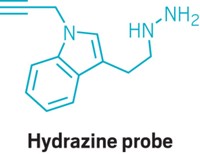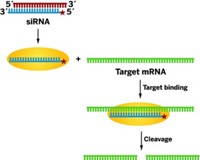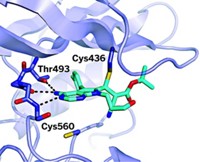Advertisement
Grab your lab coat. Let's get started
Welcome!
Welcome!
Create an account below to get 6 C&EN articles per month, receive newsletters and more - all free.
It seems this is your first time logging in online. Please enter the following information to continue.
As an ACS member you automatically get access to this site. All we need is few more details to create your reading experience.
Not you? Sign in with a different account.
Not you? Sign in with a different account.
ERROR 1
ERROR 1
ERROR 2
ERROR 2
ERROR 2
ERROR 2
ERROR 2
Password and Confirm password must match.
If you have an ACS member number, please enter it here so we can link this account to your membership. (optional)
ERROR 2
ACS values your privacy. By submitting your information, you are gaining access to C&EN and subscribing to our weekly newsletter. We use the information you provide to make your reading experience better, and we will never sell your data to third party members.
Biological Chemistry
Target-promoted DNA Alkylation
New technique may be applicable to many other reagents and targets in addition to DNA
by Stu Borman
February 2, 2004
| A version of this story appeared in
Volume 82, Issue 5

A university of maryland team has discovered a new way to alkylate single-stranded DNAs in a sequence-specific manner [Proc. Natl. Acad. Sci. USA, 100, 15452 (2003)]. The approach "should be readily generalized to many types of reagents and targets," the researchers note.
To design the alkylating agent, chemistry professor Steven E. Rokita and postdoctoral associate Qibing Zhou (now assistant professor of organic chemistry at Virginia Commonwealth University, Richmond) simply added a group for generating a quinone methide to a single-stranded DNA ligand.
A quinone methide is a highly reactive functionality capable of alkylating nearby structures, but with an even stronger tendency to react intramolecularly to form a self-adduct. In the self-adduct form, the quinone methide is inactive. However, the intramolecular reaction is reversible, so the reagent always remains ready to revert to its highly reactive form.
The DNA ligand to which the quinone methide is attached is capable of binding sequence-specifically to a DNA target strand. Binding is incomplete because the presence of the self-adduct makes some bases on the DNA ligand inaccessible to complementary bases on the DNA target.
After partial binding of the two strands occurs, the self-adduct equilibrates back to its reactive quinone methide form. When the quinone methide re-forms, conformational restrictions that initially inhibited complete interstrand base pairing are lifted, full binding of the two DNA strands occurs, and the reactive quinone methide can then alkylate a base on the complementary target strand.
The approach complements two current strategies used to alkylate DNA or other target structures selectively. Right now, one can use an affinity reagent with an attached reactive alkylating group to bring the reactive group to a target, or, if the target happens to be an enzyme, one can use a mechanism-based inhibitor to alkylate it. A mechanism-based inhibitor is a substrate analog that binds at an enzyme's active site. The reactivity of a latent reactive group on the inhibitor is triggered specifically when the enzyme tries to process the analog as if it were a regular substrate.
The problem with affinity reagents is that they've tended to exhibit insufficient specificity or they have been plagued by too many competitive interactions when people have tried to get them to work in vivo. And the problem with mechanism-based inhibitors is that they can only be used for targets with catalytic activity--making them largely inapplicable to DNA, for example, which rarely acts as a catalyst.
THE TARGET-PROMOTED alkylation system designed by Zhou and Rokita could sidestep some of these problems and could be useful for specific types of applications, such as experiments in which one would like to alkylate and thereby disable or label a specific gene sequence. This type of on-site activation system is not unique; antitumor drugs such as CC-1065, the duocarmycins, and bizelesin seem to have "thought" of it first. Such drugs work by becoming chemically activated at noncatalytic targets, a mechanism that has been demonstrated by groups such as those of chemistry professors Dale L. Boger of Scripps Research Institute and Laurence H. Hurley of the University of Arizona.
The problem is that drugs that become active only when in contact with specific DNA have predetermined and limited sequence specificity. "They'll react at DNA of a short given sequence, whether it's a cancer cell or noncancer cell," Rokita says. "We have here the chance of taking a general concept--the reversible self-adduct--and targeting it for most any sequence."
Chemistry professor Maria Tomasz of Hunter College of the City University of New York agrees that "the new process has potentially considerably greater sequence selectivity" than drugs like CC-1065 and the duocarmycins. "I can see a potential applicability in that it could lead to an improvement over the antisense approach for control of gene expression, at least in vitro."
Also asked to comment, chemistry professor Kent S. Gates of the University of Missouri, Columbia, agrees that "the work reveals concepts that might be utilized for the design of new agents that deliver potent electrophiles to a variety of protein or nucleic acid targets inside the cell."
Rokita notes that "our system is a general process. Although I'm showing it in DNA, it's a concept one might be able to use for a lot of reagents," not just DNA-quinone methide adducts. "Design of such a reagent needs only to include formation of a reversible self-adduct that is capable of enhanced target recognition after reformation of its reactive group," he says.





Join the conversation
Contact the reporter
Submit a Letter to the Editor for publication
Engage with us on Twitter